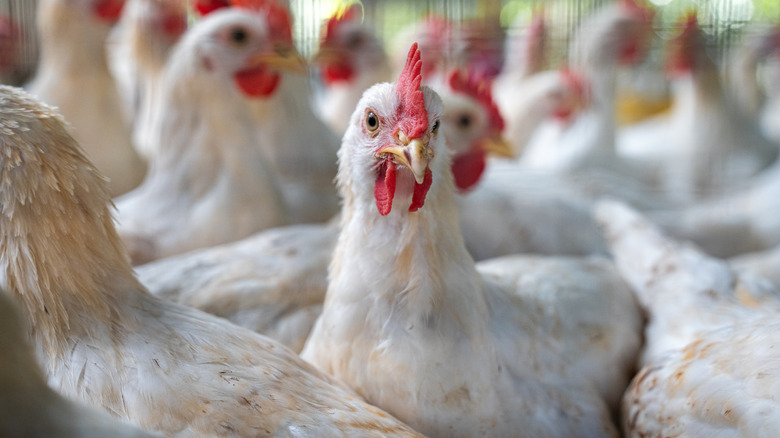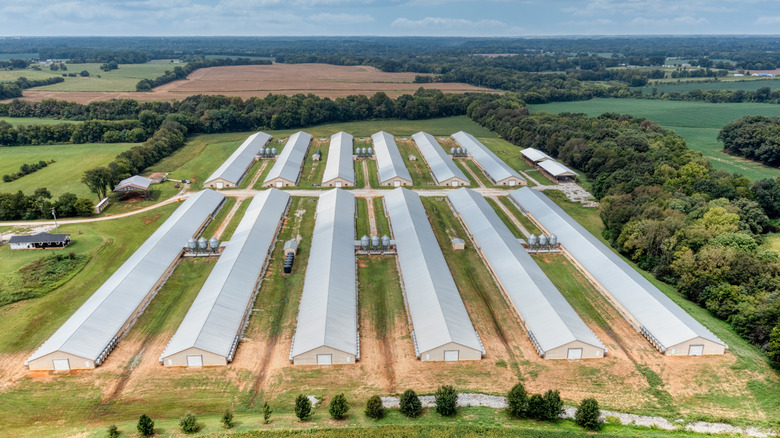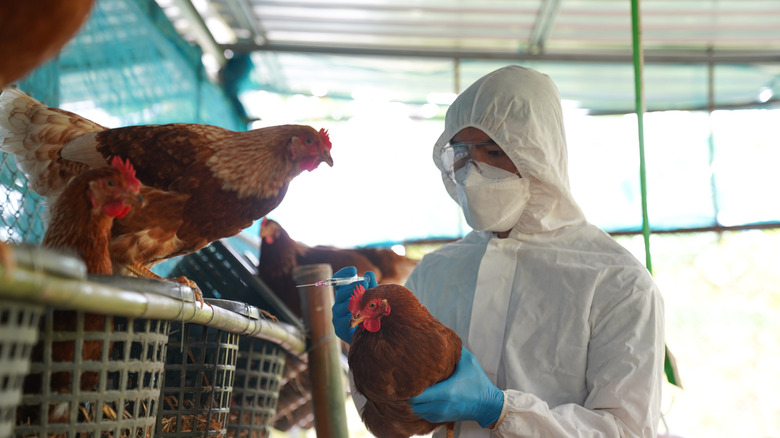The US State That Produces More Chicken Than The Rest Of The Country
Since the early 1990s, chicken has been the most highly eaten meat in the U.S., with over 102 pounds of this poultry eaten per person, per year. It makes sense; it's delicious, versatile, nutritious, relatively inexpensive (especially compared to beef), and it's almost always in stock at your grocery store, with at least seven cuts you should consider buying raw, or you can purchase it already-cooked, rotisserie-style. The U.S. is actually the top producer in the world of chicken meat, at nearly 19,600 kilotons (coming in second and third are Brazil and China, respectively). It begs the question, though — where is all this U.S.-produced chicken coming from? The state that contributes most to the U.S. chicken industry is actually Georgia.
Georgia contributes 1.3 billion chickens (known as "broilers" to distinguish them from chickens that are kept for their eggs) to the American poultry market, and the Peach State is home to 1.3 billion of the total 9 billion broilers that are kept in the U.S. Raising and slaughtering broilers make up a huge part of Georgia's economy, generating over $41.5 billion in 2024. Both Perdue Foods and Pilgrim's Pride have processing plants in the state.
How poultry became Georgia's number one industry
Broilers' history in Georgia starts with very humble beginnings, indeed. In the early part of the 20th century, some farmers in the northern part of the state (which is still the more significant producer of chicken meat, geographically, even today) thought to supplement their income by raising chickens specifically for meat sales. By the 1930s, a verifiable industry had sprung up, with as many as half a million chickens raised.
Leading the charge was Jesse Jewell, a civil engineer by training, with a flair for entrepreneurship. He took his father's feed business and began to contract with local farmers — they would grow the chickens, and he would supply the food. Gradually, though, Jewell saw the benefits of managing everything under one roof, and throughout the 1940s, he opened both a hatchery and a processing plant. In addition to creating jobs for laborers, his business also opened the doors for scientists and marketers.
The entire broiler industry grew to proportions that those early farmers could likely not have predicted, with nearly 63 million chickens produced in 1950. Then, in 1951, their efforts, and the efforts of all who came after, including Jesse Jewell, officially made Georgia the number one state in the country for chicken meat, a position it has occupied ever since.
How Georgia's poultry industry has advanced
Growth in Georgia's poultry industry was possible through the foresight of organizations, like the Georgia Poultry Improvement Association (which does business as the Georgia Poultry Laboratory Network, or GPLN) and the U.S. government-formed National Poultry Improvement Plan, founded in 1935, both of which were aimed at aiding farmers and controlling disease among flocks. In 1912, the University of Georgia established its Poultry Science department, training up successive generations of scientists, researchers, and businesspeople. All of the efforts of these organizations contributed to the explosive growth of the broiler industry in Georgia throughout the 20th century, as they allowed flocks to both remain healthy and expand in gargantuan numbers.
In the second half of the 20th century, Georgia Tech has also been crucial in advancing the poultry industry in the state, with technological advancements in plant sound reduction, improvement in skimmings (water removal from chicken byproduct), and mechanization of poultry monitoring. Further, in 2022, the USDA announced the opening of a brand new poultry research facility in Athens, Georgia, the largest of its kind, housing state-of-the-art technology to aid scientists and researchers in their ongoing quest to keep chickens disease-free, and to help prevent major safety breaches, like the October 2024 listeria-based recall.



